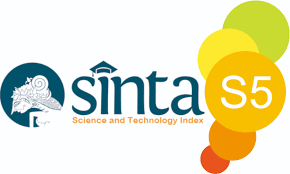Design of a Customizable Preview Feature on Clothing Website
Abstract
Clothing trends that always change over time, and the tight competition in the clothing business make producers have to rack their brains so that the business they run has additional points for consumers, ranging from changes in design, use of materials, colour selection to the promotion section. The purpose of this research is to create a custom clothing feature on the website that is useful for consumers who have a special desire for the clothes they want to buy. The research method used in this research is descriptive analysis with a quantitative approach. The results show that the addition of the Custom Clothing feature can provide better clothes ordering experience on a digital platform that can be accessed through each computer. The main concept of this feature is a choice of sizes and pieces of clothing that can be chosen without thinking about stock availability. In the end, this feature is here to help consumers who have a special desire for the clothes they want to buy, so that consumers who have special desires can have clothes from that brand without thinking about stock availabilityClothing trends that always change over time, and the tight competition in the clothing business make producers have to rack their brains so that the business they run has additional points for consumers, ranging from changes in design, use of materials, colour selection to the promotion section. The purpose of this research is to create a custom clothing feature on the website that is useful for consumers who have a special desire for the clothes they want to buy. The research method used in this research is descriptive analysis with a quantitative approach. The results show that the addition of the Custom Clothing feature can provide better clothes ordering experience on a digital platform that can be accessed through each computer. The main concept of this feature is a choice of sizes and pieces of clothing that can be chosen without thinking about stock availability. In the end, this feature is here to help consumers who have a special desire for the clothes they want to buy, so that consumers who have special desires can have clothes from that brand without thinking about stock availability
References
[2] Tangchaiburana, S., & Techametheekul, K. W. (2017). Development model of web design element for clothing e-commerce based on the concept of mass customization. Kasetsart journal of social sciences, 38(3), 242-250.
[3] Sun, Q. and Sun, X. (2021) ‘Research on the Technology of Mass Customization of Clothing’, International Journal of Modeling and Optimization, 11(3), pp. 86–93.
[4] Kiangala, S. K. and Wang, Z. (2021) ‘An effective adaptive customization framework for small manufacturing plants using extreme gradient boosting-XGBoost and random forest ensemble learning algorithms in an Industry 4.0 environment’, Machine Learning with Applications. Elsevier Ltd., 4(February), p. 100024.
[5] Noor Santi, R. C. (2018) ‘Perancangan Interaksi Pengguna (User Interaction Design) Menggunakan Metode Prototyping’, Jurnal Teknik Informatika, 9(2), pp. 108–113.
[6] Iqbal, S. Z., & Idrees, M. 2017. Z-SDLC Model a New Model for Software Development Life Cycle (SDLC). International Journal of Engineering and Advanced Research Technology (IJEART), 3(2), pp. 8.
[7] Kumar, N., Zadgaonkar, A. S., & Shukla, A. 2013. Evolving a new software development life cycle model SDLC-2013 with client satisfaction. International Journal of Soft Computing and Engineering (IJSCE), 3(1), pp. 2231-2307.
[8] Kondylakis, H., Katehakis, D. G., Kouroubali, A., Logothetidis, F., Triantafyllidis, A., Kalamaras, I., ... & Tzovaras, D. 2020. COVID-19 Mobile Apps: A Systematic Review of the Literature. Journal of medical Internet research, 22(12), e23170.
[9] Islam, M. N., Islam, I., Munim, K. M., & Islam, A. N. 2020. A review on the mobile applications developed for COVID-19: An exploratory analysis. IEEE Access, 8, pp. 145601-145610.
[10] valentino tansen, febryan, Mulyawan, B. and dolok lauro, M. (2018) ‘Pembuatan Aplikasi E-Commerce Customize Pakaian Dan Prediksi Stok Dengan Menggunakan Metode Regresi Linear Sederhana’, pp. 163–168.
[11] Suryadjaja, P. S., Hutagalung, M., & Sutarto, H. Y. (2020). Modeling traffic flows with Fluid Flow Model. International Journal of Informatics, Information System and Computer Engineering, 1(1), 1-12.
[12] Supatmi, S., Goonjur M. K., & Sumitra, I. D. (2020). Enhanced the Weighted Centroid Localization Algorithm Based on Received Strength Signal in Indoor Wireless Sensor Network. International Journal of Informatics, Information System and Computer Engineering (INJIISCOM), 1(1), 13-22
[13] Pangaribuan, I., Rahman, A., & Mauluddin, S. (2020). Computer & Network Equipment Management System (CNEMAS) Application Measurement. International Journal of Informatics, Information System and Computer Engineering (INJIISCOM), 1(1), 25-35.
[14] Singgih, I. K. (2020). Air Quality Prediction in Smart City's Information System. International Journal of Informatics, Information System and Computer Engineering (INJIISCOM), 1(1), 35-46.
[15] Iida, H., & Khalid, M. N. A. (2020). A Paradigm Shift from Optimal Play to Mental Comfort: A Perspective from the Game Refinement Theory. International Journal of Informatics, Information System and Computer Engineering (INJIISCOM), 1(1), 47-78.
[16] Hadiana, A. I. (2020). Fog Computing Architecture for Indoor Disaster Management. International Journal of Informatics, Information System and Computer Engineering (INJIISCOM), 1(1), 79-90.
[17] Atmaja, B. T., Akagi, M., & Elbarougy, R. (2020). Dimensional Speech Emotion Recognition from Acoustic and Text Features using Recurrent Neural Networks. International Journal of Informatics, Information System and Computer Engineering (INJIISCOM), 1(1), 91-102.
[18] Uriawan, W. (2020). SWOT Analysis of Lending Platform from Blockchain Technology Perspectives. International Journal of Informatics, Information System and Computer Engineering (INJIISCOM), 1(1), 103-116.
[19] Febriani, L. I., Nurhashiva, C., Veronica, J., Ragadhita, R., Nandiyanto, A. B. D., & Kurniawan, T. (2020). Computation Application: Techno-Economic Analysis on the Production of Magnesium Oxide Nanoparticles by Precipitation Method. International Journal of Informatics, Information System and Computer Engineering (INJIISCOM), 1(1), 117-128.
[20] Kanai, H., & Kumazawa, A. (2021). An Information Sharing System for Multi-Professional Collaboration in the community-based integrated healthcare system. International Journal of Informatics, Information System and Computer Engineering (INJIISCOM), 2(1), 1-14.
[21] Purnomo, H., Fitrah, F. R., Maulana, R., & Pratadina, M. M. (2021). Implementation of Information System in Indonesian Traditional Beverage Businesses. International Journal of Informatics, Information System and Computer Engineering (INJIISCOM), 2(1), 15-24.
[22] Supriyadi, A., Wang, T., Juwita, M. R., Gunaningrat, R., Safitri, S., & Cirella, G. T. (2021). Sustainability Policy in Indonesia: Case Study Economic Structure and Determinants in Banjar Municipality. International Journal of Informatics, Information System and Computer Engineering (INJIISCOM), 2(1), 25-46.
[23] Puspitawati, L., Nurhasanah, A., & Khaerunnisa, A. S. (2021). Utilization of Communication Technology for Business. International Journal of Informatics, Information System and Computer Engineering (INJIISCOM), 2(1), 47-54.
[24] Malik, S., Singh, S., Singh, N. M., & Panwar, N. (2021). Diagnosis of COVID-19 Using Chest X-ray. International Journal of Informatics, Information System and Computer Engineering (INJIISCOM), 2(1), 55-64.
[25] Kurniadianti, Y. S., Ziva, A. Z., Suryana, Y. K., Ragadhita, R., Nandiyanto, A. B. D., & Kurniawan, T. (2021). Computation in the Analysis of Techno-Economic of the Production of Al2O3 (Aluminum Oxide) Nanoparticles through Precipitation Method. International Journal of Informatics, Information System and Computer Engineering (INJIISCOM), 2(1), 65-76.
[26] Kumar, G., Gupta, S., Agarwal, D., & Tiwari, A. (2021). Virtual Voting System. International Journal of Informatics, Information System and Computer Engineering (INJIISCOM), 2(1), 77-82.
[27] Tolmatti, S. S., Jadhav, S. J., Jadhav, S. S., & Maske, M. M. (2021). Concrete Mix Design Using Particle Packing Method: Literature Review, Analysis, and Computation. International Journal of Informatics, Information System and Computer Engineering (INJIISCOM), 2(1), 83-102
[28] Maulana, H., Ginting, S. L. B., Aryan, P., Fadillah, M. R., & Kamal, R. N. (2021). Utilization of Internet of Things on Food Supply Chains in Food Industry. International Journal of Informatics, Information System and Computer Engineering (INJIISCOM), 2(1), 103-112.
[29] Veronica, J., Febriani, L. I., Nurhashiva, C., Ragadhita, R., & Nandiyanto, A. B. D., Kurniawan, T. (2021). Practical Computation in the Techno-Economic Analysis of the Production of Magnesium Oxide Nanoparticles using Sol-gel Method. International Journal of Informatics Information System and Computer Engineering (INJIISCOM), 2(2), 1-12.
[30] Ginting, S. L. B., Maulana, H., Priatna, R. A., Fauzzan, D. D., & Setiawan, D. (2021). Crowd Detection Using YOLOv3-Tiny Method and Viola-Jones Algorithm at Mall. International Journal of Informatics, Information System and Computer Engineering (INJIISCOM), 2(2), 13-22.
[31] Pratama, A. F. (2021). Sustainable and Digitized Certification of Palm Oil Production: Its Impact on the Environment in Indonesia. International Journal of Informatics, Information System and Computer Engineering (INJIISCOM), 2(2), 23-30.
[32] Hermawan, Y. A., Warlina, L., & Mohd, M. (2021). GIS-based urban village regional fire risk assessment and mapping. International Journal of Informatics, Information System and Computer Engineering (INJIISCOM), 2(2), 31-43.









